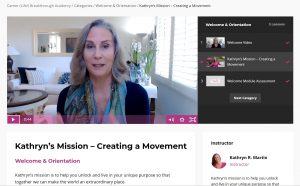As a Next Chapter Coach, I help leaders actively curate their dream scenarios; building their lives of impact – with joy, ease and revenue in alignment with their true value. It’s exhillerating.
However, without a trusted guide, the actions of someone contemplating resigning or creating a Next Chapter of some kind can often inadvertently negatively impact themselves and those around them. Even when they are happy about the change! When we understand what may be occurring internally in leaders at a crossroad moment we create the possibility for connection, joy and lasting impact.
Feelings of failure, lack of confidence and sense of identity are common when a change happens to us. My recent blog offering 10 Post-Firing Actions Amazing Leaders Can Take to Make This the Best Thing That Ever Happened to You generated the most responses to a topic I’ve ever had.
What’s interesting is that when the tables are turned and leaders are the ones deciding to leave a job, it can often bring up some of the same negative feelings.
Can you identify which of the following are quotes from someone who was fired abruptly vs someone who is in the process of making their own decision to proactively resign?
- My departure will be a “red flag” for recruiters and perspective employers.
- I feel like I’m abandoning the team who needs me.
- People are going to think I wasn’t fill in the blank enough to handle the job.
- I’m not sure what I’m going to do next.
- It’s going to be hard to secure my next role.
- What if I fail?
- I should have…fill in the blank
These statements happen to all be from a leader who was successful and thinking of resigning. They had just led their organization through a tumultuous time, making it possible for the organization to now begin to envision a new future – and likely mount a big campaign. While this was exciting, the leader said “I just don’t have it in me” to ramp up again. However, while they didn’t want to continue in the job, they felt like 1. they “should” continue to help the organization continue forward out of loyalty, professionalism and care, and 2. the thought of applying for new jobs wasn’t appealing, especially with all the possible options to consider, including going into consulting, writing a book, or finally getting to spend some time at home during the day! Running all the scenarios and trying to make a decision was starting to feel a little overwhelming and kept getting put off. The easy decision was to just stay and try to be grateful.
But here’s the hidden challenge(s) for leaders trying to make Next Chapter decisions:
- It is easy to misinterpret or dismiss our own instincts, self-assessments and feelings – not valuing or understanding them for what they may be really revealing.
- Limiting beliefs can show up as societal norms which may not apply in our specific case. In many cultures we’re taught as children not to be a “quitter” – in school, in sports, when facing challenges and adversity. Leaders are honored for their persistence, sticking with something, through times of rejection, doubt, fear.
- In late career or Founder scenarios, departure can heighten reflections on one’s mortality and legacy.
- It’s hard to know if we are running away from the very challenge that will provide us an opportunity to stretch and grow, or if we’re accurately assessing that the situation cannot create what we need to be our best selves.
- Assumptions about what is and is not possible for us in our career/life are based upon what may be irrelevant (for us) best practices, expert advice, and the experiences of others.
- Skills, education, experience and tasks are considered to be the indicators of our value and thus determine the best next steps to advance, rather than what occurs to others when we apply them all successfully – in the unique and almost effortless way we lead when we are in our “sweet spot.”
And, to make things worse, if you are thinking about making a change but haven’t yet, it may be that some pesky “voices in your head” have caused you to:
- Believe that the pulling that you are feeling isn’t real and you just need to push through…again. It’s “just what being a professional in my field looks like.”
- Have others figure out what you (really) want. You may not know if what you want is even possible, or how to find out. You talked to recruiters, mentors, friends and family, you Googled job postings late into the night until your eyes burned – and everyone has a different opinion.
- Invest time and money in a resume writer, career coach, certification program – and you didn’t get the outcome you wanted (you may have even got the job you thought you wanted, and then still not be happy).
- Keep delaying making your Next Chapter decisions, because the job that you’re unhappy in always gets in the way. There are projects that you need to finish first, family matters you need to take care of first, plants that need to be watered first. 😉
- And the worst thing, you may have given up, or want to… and if this is the case, please read on!
Without first uncovering what I call key “Foundational Impact Insights” on yourself, being able to create your dream scenario (a career/life of impact, joy, ease, revenue in alignment with your true value, and everything you need to show up fully) is going to be… a crap shoot. Now, to be sure, after years in Executive Search I know that there are many successful leaders who have built careers without this “intel.”
However, this is what I know:
FACT:
The world needs you to be living in your dream scenario SO THAT you can have the impact on others you are meant to have. I’ve worked with hundreds of leaders and it is always 100% true.
So! How do leaders go about curating their dream scenario? That’s my favorite question. It’s also exactly why I created The Career (Life!) Breakthrough Academy – and why I’m offering it as part of a new “Spring Forward” Coaching Package!
In the client example I used earlier, after coaching with me for two weeks, the leader’s original shame of giving up – “I just don’t have it in me” – turned out to really be “I am absolutely energized when I’m leading a turn-around situation. For as long as I can remember, I’ve been able to help guide groups of people forward when everything around them seemed bleak. It’s what I do – in fact, the part that really matters to me often feels effortless. I am energized by knowing how to create confidence, momentum, and transformative shifts. I do my best work in intense spurts of activity. Now that we’ve reached this big milestone together, it’s time for me to pass the baton so that I can help a new organization (or many!) in this way.“ [cheers from the crowd]
Connecting to how they work best and why, what brings them joy, and how they make a difference to others when they are at their best then enabled us to reverse-engineer the “next steps” to consider. For this leader, the “right” decision was to leave – and now, they could create the elevated messaging to explain why!
Why does all this matter? I’m not planning on quitting my job. I’m happy!
When colleagues are contemplating making a shift of some kind, it can be a time of tremendous vulnerability, and – depending on the person – can show up in a number of ways. Their actions can often negatively impact those around them.
- I’ve led ten arts & culture non-profits as their Interim CEO between their permanent leaders, I’ve coached and trained interim leaders around the country. I’ve seen the inadvertent damage caused to teams, to revenue, and to stakeholder engagement when outgoing leaders have prolonged their decisions to resign – even when they are miserable.
- I’ve supported searches where I’ve seen wonderful leaders apply for (and get) jobs that they end up not being happy in, or apply for and never get selected. Either way, it was often due to a lack of self-clarity on what they (really) wanted, what kinds of internal and external environments they would thrive in (and not), and what they organization (really) wanted.
- I’ve seen extraordinary leaders get disillusioned and start playing small, or start resisting new ways of doing things, and thus not be able to help the very people and organizations that are needing them.
Three Actions You Can Take to
Support Someone Trying to Decide Whether to
Leap into a Next Chapter.
NOTE: You can also do these for yourself!
(pulled from some of the coaching happening in The Academy)
- Help them (you?!) feel SEEN – tell them how they impact you. Go beyond the transactional – don’t focus solely on how well they do a task or a job. Convey what happens to others as a result of those things. And, more importantly, what occurs when they “show up” fully as their funny/quirky/serious self? How do they make people feel, or know? What is their impact simply by BE-ing? If you don’t know the answers, begin observing!
- Help them (you?!) envision how they want to feel, what will occur for others when that happens, and why that’s so amazing. This shift of focus helps begin to reveal what we’re (really) seeking in our Next Chapter – no matter what our role.
- Connect them (you?!) to me. I specialize in helping leaders at crossroad moments launch into their extraordinary Next Chapters. It brings me joy. I’ve created a proven process that works regardless of age, industry or scenario – and together we’re creating a MOVEMENT. Please share this BLOG with the person you know. And, if you’ve been thinking about contacting me, please don’t hesitate any longer. The new “Spring Forward” Coaching Package is available right now, and I’m offering free Strategy Calls next week (only).
To your success!
Kathryn
Kathryn R Martin,
“Next Chapter” Coach
Creator of The Career (Life!) Breakthrough Academy
Leadership Transition Strategist & Professional Interim CEO




